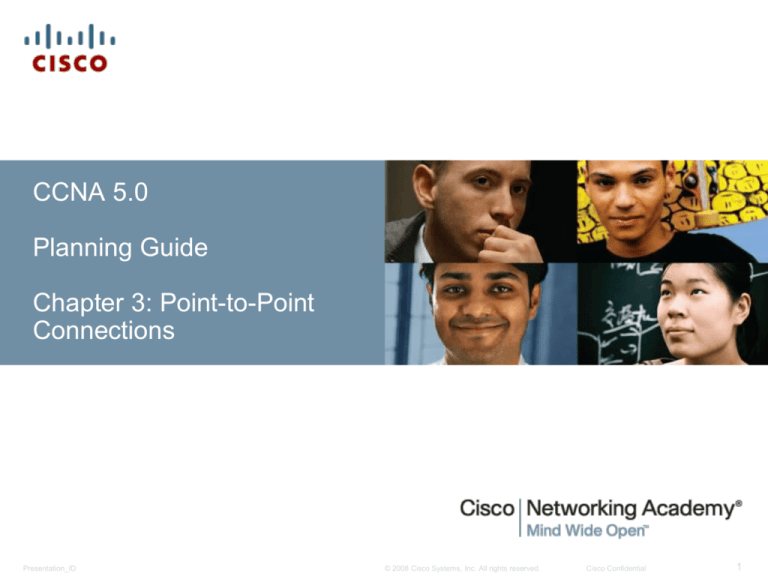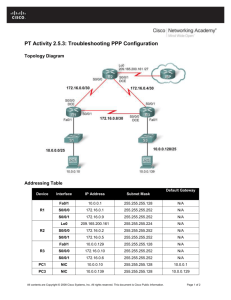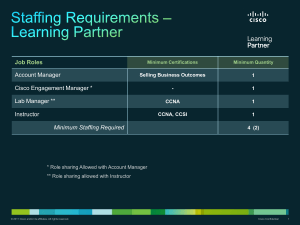
CCNA 5.0
Planning Guide
Chapter 3: Point-to-Point
Connections
Presentation_ID
© 2008 Cisco Systems, Inc. All rights reserved.
Cisco Confidential
1
Chapter 3: Objectives
In this chapter, you will be able to:
Explain the fundamentals of point-to-point serial communication
across a WAN.
Configure HDLC encapsulation on a point-to-point serial link.
Describe the benefits of using PPP over HDLC in a WAN.
Describe the PPP layered architecture and the functions of LCP and
NCP.
Explain how a PPP session is established.
Configure PPP encapsulation on a point-to-point serial link.
Configure PPP authentication protocols.
Use show and debug commands to troubleshoot PPP.
Presentation_ID
© 2008 Cisco Systems, Inc. All rights reserved.
Cisco Confidential
2
Chapter 3: Overview
This chapter covers the terms, technology, and protocols used in
serial connections.
The HDLC and Point-to-Point Protocols (PPP) are introduced.
PPP is a protocol that is able to handle authentication, compression,
error detection, monitor link quality, and logically bundles multiple
serial connections together to share the load.
Presentation_ID
© 2008 Cisco Systems, Inc. All rights reserved.
Cisco Confidential
3
Chapter 3: Activities
What activities are associated with this chapter?
3.0.1.2 Class Activity – PPP Persuasion
3.1.1.11 Activity - Identify the Serial Communications Terminology
3.1.2.6 Syntax Checker – Troubleshooting a Serial Interface
3.1.2.7 Packet Tracer – Troubleshooting Serial Interfaces
3.2.2.5 Activity – Identify PPP Features and Operations
3.2.3.6 Activity – Identify the Steps in the LCP Link Negotiation
Process
3.3.1.4 Syntax Checker – PPP Link Quality Monitoring Command
3.3.2.6 Syntax Checker – PAP and CHAP Authentication
Configuration
3.3.2.7 Packet Tracer – Configuring PAP and CHAP Authentication
3.3.2.8 Lab – Configuring Basic PPP with Authentication
Presentation_ID
© 2008 Cisco Systems, Inc. All rights reserved.
Cisco Confidential
4
Chapter 3: Activities (cont.)
What activities are associated with this chapter?
3.4.1.4 Packet Tracer – Troubleshooting PPP with Authentication
3.4.1.5 Lab – Troubleshooting Basic PPP with Authentication
3.5.1.1 Class Activity – PPP Validation
3.5.1.2 Packet Tracer – Skills Integration Challenge
Presentation_ID
© 2008 Cisco Systems, Inc. All rights reserved.
Cisco Confidential
5
Chapter 3: Packet Tracer Activity Password
The password for all the Packet Tracer activities in this chapter is:
PT_ccna5
Presentation_ID
© 2008 Cisco Systems, Inc. All rights reserved.
Cisco Confidential
6
Chapter 3: Assessment
Students should complete the Chapter 3 Exam after completing
Chapter 3.
Worksheets, labs and quizzes can be used to informally assess
student progress.
Presentation_ID
© 2008 Cisco Systems, Inc. All rights reserved.
Cisco Confidential
7
Chapter 3: New Terms
What terms and commands are introduced in this chapter?
3.1.1.1
3.1.1.2
3.1.1.4
3.1.1.5
3.1.1.6
3.1.1.7
Presentation_ID
Point-to-point Connection
Serial Communication
Parallel Communication
RS-232
V.35
HSSI
Multiplexing
Time-division Multiplexing
Multiplexer
Statistical Time-division Multiplexing
Synchronous Optical Network (SONET)
Synchronous Digital Hierarchy (SDH)
Local Loop
Customer Premises Equipment (CPE)
Demarcation Point
CSU/DSU
Network Terminating Unit (NTU)
© 2008 Cisco Systems, Inc. All rights reserved.
Cisco Confidential
8
Chapter 3: New Terms (cont.)
What terms and commands are introduced in this chapter?
3.1.1.8
DTE
DCE
Electronics Industry Association (EIA)
International Telecommunication Union Telecommunications
Standardization Sector (ITU-T)
3.1.1.9 null modem
DB9
DB60
EIA/TIA-232
EIA/TIA-449
X.21
EIA/TIA-530
Smart serial cable
3.1.1.10 DS0, DS1, etc.
T1/T3
E1/E3
OC-X
Presentation_ID
© 2008 Cisco Systems, Inc. All rights reserved.
Cisco Confidential
9
Chapter 3: New Terms (cont.)
What terms and commands are introduced in this chapter?
3.1.2.1
3.1.2.3
3.1.2.5
3.2.1.1
Presentation_ID
HDLC
PPP
Serial Line Internet Protocol (SLIP)
X.25/Link Access Procedure Balanced (LAPB)
Frame Relay
PAP
CHAP
ATM
Circuit-switched
Packet-switched
Information Frames (I-frames)
Supervisory Frames (S-frames)
Unnumbered Frames (U-frames)
show controllers serial command
Link Control Protocol (LCP)
Network Control Protocols (NCPs)
IPv4, IPv6, Novell IPX, AppleTalk Control Protocol
© 2008 Cisco Systems, Inc. All rights reserved.
Cisco Confidential
10
Chapter 3: New Terms (cont.)
What terms and commands are introduced in this chapter?
3.2.1.2
3.2.2.4
3.2.3.1
3.2.3.2
3.2.3.3
Presentation_ID
Password Authentication Protocol (PAP)
Challenge Handshake Authentication Protocol (CHAP)
Frame Check Sequence (FCS)
Link Establishment And Configuration Negotiation
Link Quality Determination
Network Layer Protocol Configuration Negotiation
Configure-Request
Configure-Ack
Configure-Nak
Configure-Reject
Code-Reject
Protocol-Reject
Echo-Request
Echo-Reply
Discard-Request
Terminate-Request
Terminate-Ack
Code Identifier
© 2008 Cisco Systems, Inc. All rights reserved.
Cisco Confidential
11
Chapter 3: New Terms (cont.)
What terms and commands are introduced in this chapter?
3.2.3.4
3.3.1.1
3.3.1.2
3.3.1.3
3.3.1.4
3.3.1.5
3.3.1.6
3.3.2.2
3.3.2.3
3.3.2.5
3.3.2.6
Presentation_ID
Compression
Multilink
Stacker
Predictor
Error Detection
Magic Number
PPP Callback
encapsulation ppp command
compress predictor command
ppp quality percentage command
interface multilink 1 command
ppp multilink command
ppp multilink group 1 command
show ppp multilink command
ppp authentication pap command
Message Digest 5 (MD5)
ppp authentication chap command
username name password password command
© 2008 Cisco Systems, Inc. All rights reserved.
Cisco Confidential
12
Chapter 3: New Terms (cont.)
What terms and commands are introduced in this chapter?
3.4.1.1
3.4.1.2
3.4.1.3
Presentation_ID
debug
debug
debug
debug
debug
ppp
ppp
ppp
ppp
ppp
command
packet command
negotiation command
error command
authentication command
© 2008 Cisco Systems, Inc. All rights reserved.
Cisco Confidential
13
Chapter 3: Best Practices
Prior to teaching Chapter 3, the instructor should:
Complete Chapter 3 Assessment.
Ensure all activities are completed. This is a very important
concept and hands-on time is vital.
Provide the students many PPP troubleshooting activities.
Encourage students to login with their cisco.com login and
download
http://docwiki.cisco.com/wiki/Internetworking_Technology_Handbo
ok
Presentation_ID
© 2008 Cisco Systems, Inc. All rights reserved.
Cisco Confidential
14
Chapter 3: Additional Help
For additional help with teaching strategies, including lesson plans,
analogies for difficult concepts, and discussion topics, visit the
CCNA Community at http://community.netacad.net/web/ccna/files.
If you have lesson plans or resources that you would like to share,
upload them to the CCNA Community to help other instructors.
Presentation_ID
© 2008 Cisco Systems, Inc. All rights reserved.
Cisco Confidential
15
Chapter 3: Topics Not in ICND2 200-101
This section lists topics covered by this chapter that are NOT listed
in the ICND2 200-101 Blueprint. Those topics are posted at
http://www.cisco.com/web/learning/exams/list/icnd1b.html.
Instructors could skip these sections; however, they should provide
additional information and fundamental concepts to assist the
student with the topic.
ALL TOPICS IN CHAPTER 3 ARE OBJECTIVES OF THE ICND2.
Presentation_ID
© 2008 Cisco Systems, Inc. All rights reserved.
Cisco Confidential
16
Presentation_ID
© 2008 Cisco Systems, Inc. All rights reserved.
Cisco Confidential
17
Presentation_ID
© 2008 Cisco Systems, Inc. All rights reserved.
Cisco Confidential
18







